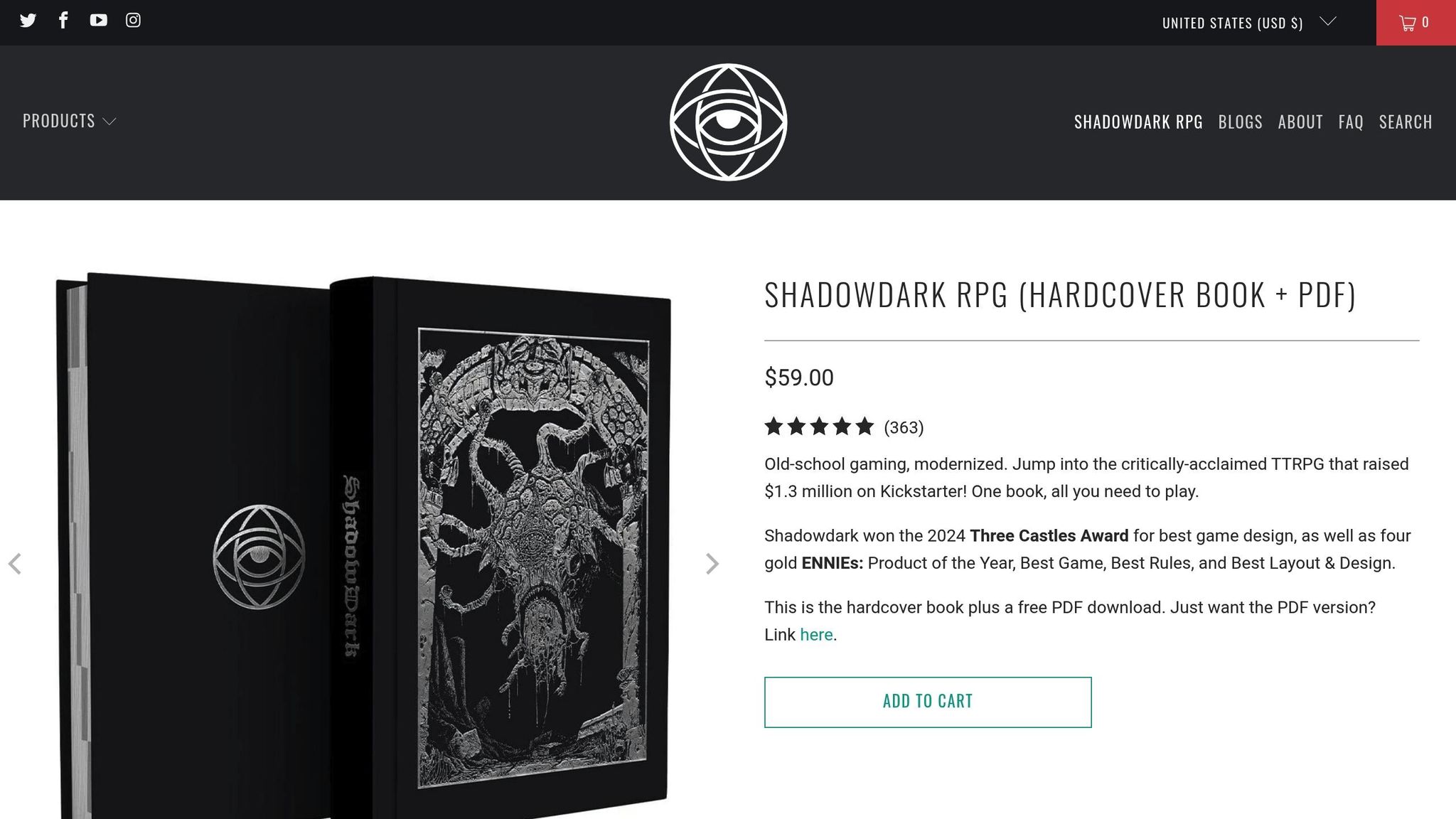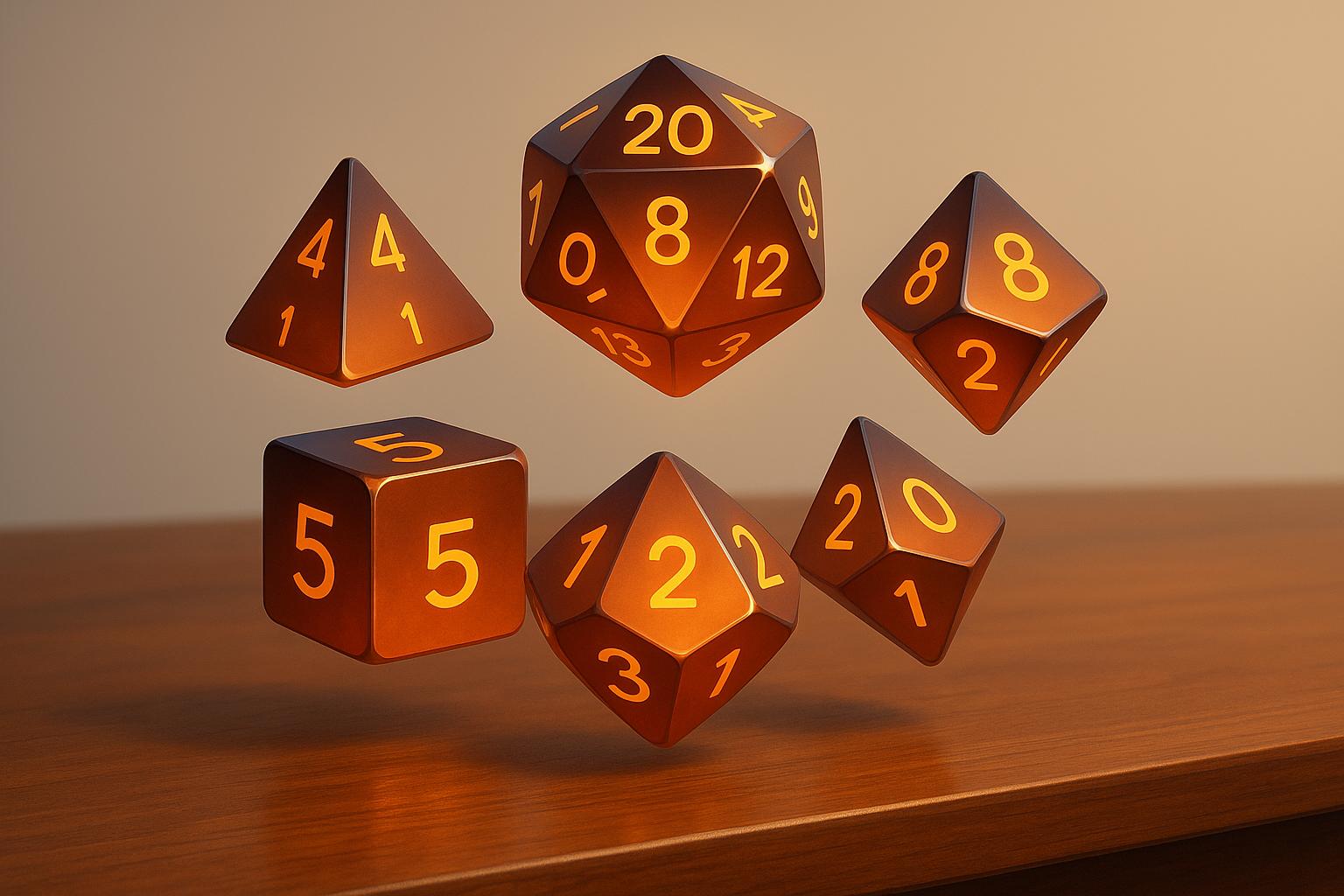Want to transform your classic RPG module into a fast-paced, story-driven NSR (New School Revolution) system? You can do it in just one afternoon. Here’s the quick process:
- Simplify Stats: Strip down complex character and monster stat blocks to just the essentials.
- Rebuild Encounters: Create flexible, narrative-focused challenges with multiple solutions.
- Update Rewards: Shift from XP and loot to meaningful in-game items, relationships, and knowledge.
- Keep the Core Story: Retain the original module’s main objectives, key NPCs, and themes while making descriptions concise and evocative.
Why Convert to NSR?
NSR systems prioritize storytelling, creativity, and player-driven decisions over rigid rules and stat-heavy gameplay. This makes gameplay faster, deadlier, and more immersive.
Quick Comparison: Traditional RPGs vs. NSR Systems
| Feature | Traditional RPGs | NSR Systems |
|---|---|---|
| Mechanics | Complex, rule-heavy | Lightweight, simplified |
| Character Progression | Stat and level increases | Survival and story-driven |
| Combat | Detailed, tactical | Quick, deadly, narrative-led |
| Player Focus | Stats and abilities | Creativity and decisions |
| Storytelling | Pre-planned, rigid | Emergent, player-driven |
Set up your workspace, follow the steps, and test your conversion. The result? A streamlined module that keeps the spirit of the original while embracing NSR’s simplicity and creativity.
Core Concepts of NSR Systems
NSR vs Standard RPG Mechanics
NSR systems simplify tabletop RPGs by focusing on storytelling and minimizing complex rules. Unlike traditional RPGs, which rely on various dice types and intricate stat blocks, NSR systems strip mechanics down to the essentials.
Here’s how they differ:
Rules and Resolution: Traditional RPGs often use multiple dice and detailed skill systems. NSR systems, on the other hand, rely on a single type of roll or a straightforward luck-based approach.
Character Development: In traditional systems, characters progress through stats, abilities, and equipment upgrades. NSR systems focus on advancement through in-game experiences and survival rather than numerical level-ups.
These contrasts highlight the core principles of NSR systems, which are crucial when adapting modules for this style of play.
Key Elements for Module Conversion
When converting a module to fit NSR systems, focus on these essential elements:
Living World Elements: NSR games shine in dynamic settings where events evolve independently of player actions.
Weird Setting Integration: Surreal or strange elements are a hallmark of NSR games. You can amplify existing oddities or subtly introduce new ones that align with the original story.
Here’s a quick look at how traditional RPG elements translate into NSR adaptations:
| Traditional Element | NSR Adaptation |
|---|---|
| Detailed Stat Blocks | Simplified Stats and GM Rulings |
| Skill Check System | Luck Rolls and Player Creativity |
| Experience Points | Survival-Driven Advancement |
| Rigid Combat Rules | Narrative-Focused Encounters |
| Fixed Lore | Flexible, Open-Ended Details |
The heart of a successful conversion lies in adopting NSR's philosophy: lightweight mechanics that prioritize storytelling. This approach frees Game Masters to focus on crafting immersive narratives without being bogged down by rule-heavy systems.
NSR systems revolve around a few key principles:
- Player-driven storytelling, where players shape the narrative.
- Quick and deadly combat, keeping encounters intense and impactful.
- Creative problem-solving, favoring ingenuity over rigid mechanics.
- Emergent narratives, allowing the story to unfold naturally during play.
Setting Up Your Conversion Workspace
Required Tools and Resources
Having a well-organized workspace can make the process of module conversion much smoother and more efficient.
Digital Tools You’ll Need:
- A dependable note-taking app like Notion to keep track of module components.
- Easy access to your original module materials, whether in PDF format or a physical copy.
- Spreadsheet software to keep tabs on your conversion progress.
- Cloud storage (e.g., Google Drive, Dropbox) for backing up your work and sharing it with players.
Physical Tools to Have on Hand:
- Printed reference sheets that outline NSR mechanics.
- Notepads or index cards for jotting down quick ideas or notes.
- Highlighters to mark important elements in the original module.
- Small containers or bins for organizing physical materials.
| Workspace Component | Purpose | Organization Tip |
|---|---|---|
| Digital Workspace | Module conversion and reference | Create dedicated folders for original content, drafts, and completed materials. |
| Physical Setup | Quick access to essential materials | Use small storage baskets or organizers for reference books and tools. |
Workspace Setup Tips
A thoughtfully arranged workspace helps you stay focused and speeds up the conversion process.
For Physical Organization:
- Use trays to group related materials for easy access.
- Consider a pull-out shelf or an extra desk area for additional working space.
- Keep your cables neat and out of the way with cable organizers.
For Digital Organization:
- Develop a template system to ensure your conversions follow a consistent format.
- If possible, use a dual-monitor setup - one screen for the original module and the other for your conversion work.
To keep everything accessible, divide your materials into these categories:
| Category | Contents | Storage Solution |
|---|---|---|
| Core Reference | NSR rules, original module | Desktop file holder |
| Work in Progress | Current conversion materials | Plastic basket within arm’s reach |
| Digital Assets | Maps, handouts, notes | Cloud-synced folder structure |
Once your workspace is set up and ready to go, you’ll be well-equipped to begin the conversion process with ease.
Converting an Adventure To Use With Shadowdark RPG!

3 Steps to Convert Your Module
With your workspace now in order, it’s time to tackle the actual conversion process. Here’s a straightforward guide to help you transform your module effectively.
Step 1: Simplify Stats
When converting complex stat blocks into NSR-friendly formats, the goal is to focus on what’s essential. Strip away unnecessary details and zero in on the core traits that define creatures or NPCs.
How to Simplify Core Stats:
- Replace detailed attribute scores with simple, streamlined ratings.
- Highlight key abilities that make each character or creature stand out.
- Shift the focus from heavy numerical data to descriptive, narrative-driven elements.
Here’s a quick reference table for stat conversions:
| Original Element | NSR Conversion | Purpose |
|---|---|---|
| Multiple Attributes | Single Rating | Simplifies decision-making |
| Complex Skills | Key Abilities | Highlights character uniqueness |
| Detailed Combat Stats | Resource Drain Value | Reflects NSR’s resource mechanics |
Once you’ve simplified the stats, apply these principles to refine the encounters.
Step 2: Rebuild Encounters
Encounters in NSR thrive on flexibility and creativity. Instead of rigid combat scenarios, design encounters that encourage multiple solutions and reward inventive thinking.
Core Elements for Encounter Design:
- Add reaction tables to keep encounters unpredictable and dynamic.
- Incorporate challenges that test players’ resource management skills.
- Build in opportunities for players to solve problems creatively.
Here’s how to rebuild encounters step by step:
- Environmental Integration: Make the environment a key factor in resolving encounters. Include interactive elements - like collapsing walls or hidden levers - that players can use creatively.
- Multiple Approaches: Design scenarios that allow for various solutions, such as negotiation, stealth, combat, or clever use of limited resources.
- Dynamic Outcomes: Use morale systems and reaction tables to create encounters that feel alive and ever-changing.
Step 3: Update Rewards
In NSR, rewards should feel tangible and impactful, enhancing both gameplay and the story. Move away from abstract progression systems and focus on in-game benefits players can directly use or experience.
Reward Types That Work Best:
- Practical items with clear, immediate uses.
- Knowledge that opens up new opportunities or reveals secrets.
- Relationships with influential NPCs that can shift the story.
- Resources that directly influence the game world.
Here’s a breakdown of effective reward types:
| Reward Type | Purpose | Examples |
|---|---|---|
| Knowledge Items | Drives Story Progress | Ancient maps, hidden lore, secrets |
| Political Gains | Shapes the World | Titles, land, guild affiliations |
| Resource Access | Expands Gameplay | Rare materials, unique equipment |
sbb-itb-b8b00a5
Keep the Original Module's Core Elements
Switching to NSR (New School Revolution) doesn't mean losing the charm of your classic module. By zeroing in on the core story elements and tweaking the presentation, you can keep the adventure's essence intact while embracing a more streamlined approach.
Maintain Key Story Points
At the heart of every classic module are its key story elements - the driving forces behind the narrative. These are the pieces you’ll want to hold onto while trimming away the unnecessary fluff.
What to Keep:
- The main objective and central obstacle: For example, the goal might be retrieving a powerful artifact, while the challenge is an ancient guardian standing in the way.
- Key encounters: Focus on moments that directly feed into the story’s climax.
- Critical NPCs: Retain characters who shape the story’s direction, but simplify their details.
- The central theme or "Controlling Idea": This is the story’s big takeaway - make sure it’s clear and upfront.
To simplify this process, try breaking the story down into a basic framework:
| Story Element | Original Format | Simplified NSR |
|---|---|---|
| Main Objective | Complex quest chain | A single, clear goal |
| Core Obstacle | Multiple stat-based challenges | One major, narrative-driven threat |
| Key NPCs | Detailed stat blocks | Memorable traits and motivations |
| Story Theme | Hidden in background text | An explicitly stated premise |
Once you’ve identified these elements, shift your focus to refining the presentation. Replace lengthy descriptions with prompts that inspire creativity and let players take the reins.
Transform Text Descriptions
One of the hallmarks of NSR is its reliance on concise, evocative descriptions. Instead of bogging players down with pages of text, you’ll provide vivid prompts that encourage imagination and interaction.
How to Simplify Descriptions:
- Use sensory cues to replace long-winded room or trap descriptions, turning them into atmospheric challenges players can engage with.
- Swap out NPC personality tables for a handful of distinctive traits that make characters memorable.
"Player creativity over character stats: There are no lists of skills and feats in the game. Players will rely on their ingenuity and lateral thinking to overcome challenges. Referees will reward cleverness and creativity."
- Scott Malthouse, Trollish Delver Games
When reworking descriptions, focus on how each element serves the story and sparks imagination:
| Original Element | NSR Presentation | Purpose |
|---|---|---|
| Room Details | Evocative Prompts | Inspires player imagination |
| Monster Stats | Key Behaviors | Encourages creative problem-solving |
| Treasure Lists | Story-Driven Rewards | Ties rewards to narrative progress |
NSR also prioritizes story-driven character progression over traditional stat increases. This means characters grow through their experiences and choices rather than leveling up through numbers. Your descriptions should reflect this philosophy by emphasizing how elements contribute to the narrative, creating moments that feel meaningful rather than mechanical.
Test and Improve Your Conversion
Testing your NSR conversion is key to ensuring it strikes the right balance between challenge and engagement.
Quick Testing Methods
Start by conducting solo tests to catch potential issues before introducing the system to a group.
Core Testing Approaches:
-
Solo Combat Simulations
Run combat scenarios using various character types. Keep an eye on:- How many rounds it takes to resolve encounters
- Resource usage (e.g., spells, health, items)
- Available tactical choices for players
-
Stress Testing Challenges
Create a low-level adventure with a mix of challenges. Focus on:- How skills and abilities interact with NSR mechanics
- Handling obstacles that lack traditional stats
- Ensuring the narrative flows smoothly
| Testing Focus | What to Check | Indicators |
|---|---|---|
| Combat Balance | Damage output, survival chances | Encounters resolve in predictable rounds |
| Skill Challenges | Problem-solving options | Multiple valid ways to approach challenges |
| Story Flow | Plot point connections | Clear and logical narrative progression |
Once solo testing confirms the system is functional, bring in players to gather their input and refine further.
Using Player Input
Player feedback is invaluable for fine-tuning your conversion. It helps highlight areas that might not be obvious during solo testing.
Effective Feedback Collection:
- Record playtest sessions for detailed review later.
- Apply the "Four F's" framework: Facts, Feelings, Findings, and Future.
- Look for recurring themes in the feedback to identify patterns.
"Also the way feedback works is that 99% of the time, playtesters suggestions are rubbish. What's not rubbish is that they are making suggestions to sort out problems that they've identified but aren't telling you." – ghostctrl, RPG Forum User
When analyzing feedback, focus on these areas:
| Feedback Area | Warning Signs | Positive Indicators |
|---|---|---|
| Rules Clarity | Frequent rule clarifications | Smooth and intuitive gameplay |
| Player Engagement | Excessive overthinking | Quick and confident decision-making |
| Story Impact | Mechanics overshadowing story | Emphasis on character-driven choices |
Refinement Guidelines:
- Prioritize trends over isolated comments.
- Stick to consistent core mechanics to avoid confusion.
- Ensure skills have meaningful applications in gameplay.
- Design failure states that are engaging and productive, rather than frustrating.
Conclusion: Finishing Your NSR Conversion
Converting classic modules to NSR systems is all about keeping the essence of the original while leaning into NSR's focus on player freedom and simplified mechanics. To help you stay on track, here's a quick checklist to ensure your conversion stays true to NSR principles.
"The mantra is 'convert the fluff, not the crunch.' Trying to re-create the minutia of system-A in system-B is a bit of a fool's errand. Better to understand what system-A is delivering as a game-experience, and then pick the tools in system-B that will give a similar feel but from a different process/execution." – dbm
Key Points to Check
| Aspect | Success Indicators | Warning Signs |
|---|---|---|
| Player Agency | Multiple solution paths available | Over-reliance on stat checks |
| Resource Management | Meaningful equipment choices | Bloated item lists |
| Experience System | Clear advancement opportunities | Traditional XP tracking |
| Challenge Design | Player skill-based solutions | Stat-dependent outcomes |
When refining your equipment list, stick to tools that are practical and reinforce the module's theme. This ensures your items feel purposeful rather than overwhelming. Adjust stats, rebuild encounters, and tweak rewards to align with NSR's streamlined approach.
Finally, test your conversion with real players. Observing their reactions during gameplay will highlight what works and what needs adjustment. This playtesting phase is crucial - it’s where you’ll see if your updates to stats, encounters, and rewards create the engaging experience NSR is known for. With these final touches, your classic module is ready to thrive in its NSR form.
FAQs
What are the key advantages of converting a classic RPG module to an NSR system?
Converting a classic RPG module to an NSR (New School Revolution) system can bring a fresh dynamic to your gaming sessions. Here's why:
- Streamlined mechanics: NSR systems are designed to be rules-light, which means they're quicker to pick up and play. You’ll spend less time flipping through rulebooks and more time immersed in the game.
- Focus on storytelling: With NSR, the emphasis is on player-driven narratives. Stories unfold naturally based on the players' decisions, rather than being confined to a rigid, pre-written script.
- Room for creativity: NSR thrives on imaginative problem-solving and encourages players to think outside the box. Whether blending genres or exploring unconventional settings, the system supports inventive gameplay.
These elements make NSR systems perfect for creating a collaborative and engaging experience that keeps everyone at the table involved and inspired.
How can I adapt a classic RPG module to NSR mechanics without losing its original story and feel?
To bring a classic RPG module into the realm of NSR mechanics while keeping its story intact, the key is to simplify the rules and lean into player-driven storytelling. Since NSR thrives on flexibility and imagination, focus on retaining the original plot and character motivations, but give players the freedom to influence the story in unexpected ways.
Keep the module's distinctive setting and themes alive by designing a world that actively responds to player decisions. Streamline stat blocks, adjust encounters to fit NSR's lighter mechanics, and center the experience on collaborative storytelling. This approach lets you maintain the original module's essence while injecting the creativity and fluidity that NSR players love.
What tools and resources do I need to convert a classic RPG module for an NSR system?
How to Convert a Classic RPG Module for an NSR System
Converting a classic RPG module for a New School Revolution (NSR) system doesn’t have to be a daunting task. With the right tools and resources, you can streamline the process and ensure a seamless adaptation.
First, make sure you have a full set of dice - d4, d6, d8, d10, d12, and d20. These are the backbone of gameplay in most NSR systems and will be essential throughout your sessions. Additionally, downloading NSR-specific character sheets can be a game-changer. These sheets are tailored to fit NSR's simplified mechanics, making character creation and tracking much easier.
When it comes to adapting older modules, look for tools that help simplify rules and mechanics. For example, FORGE is a great resource. It offers practical guidance on adapting character creation, encounters, and inventory systems, ensuring the module stays true to its original spirit while aligning with NSR’s streamlined approach. These tools can save you time and effort, letting you focus on what matters most - bringing the adventure to life.


